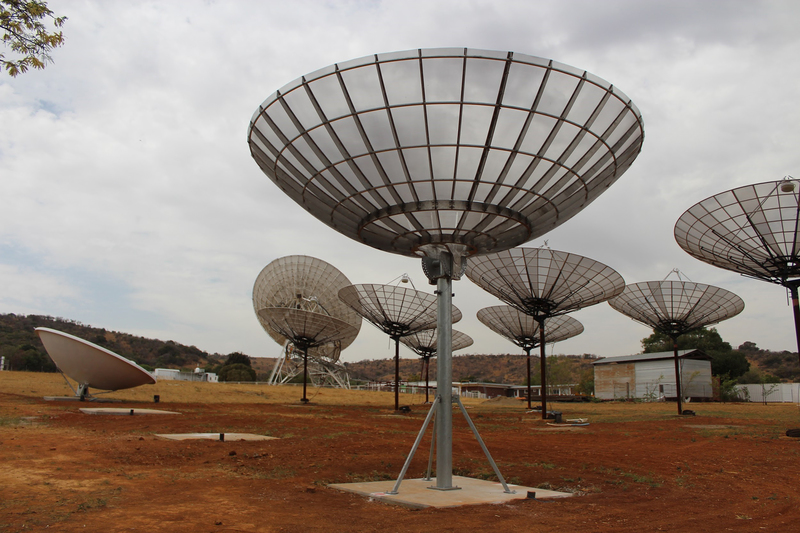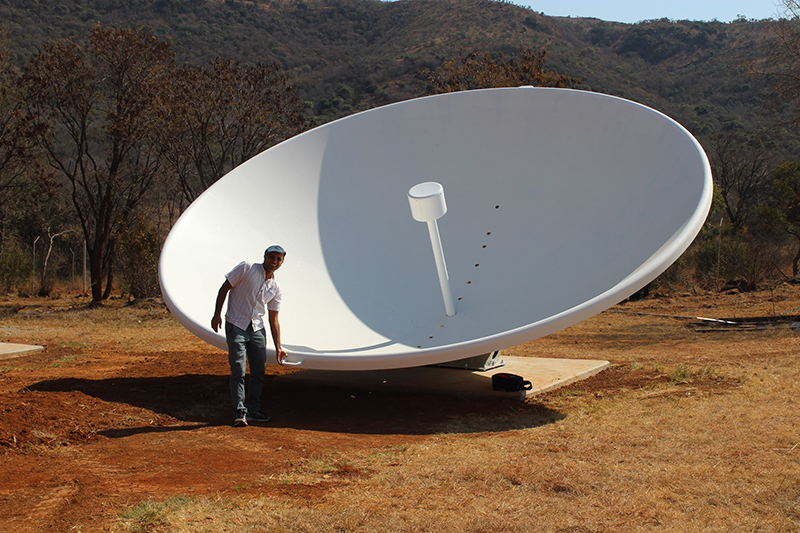HIRAX telescope milestone
21 October 2019 | Story staff writer. Photo supplied. Read time 5 min.
The Hydrogen and Real-time Analysis eXperiment (HIRAX) hit a milestone this past week with the launch of its prototype, custom-built telescope dishes. HIRAX, led by the University of KwaZulu-Natal (UKZN) with collaborators including the University of Cape Town (UCT), is a planned radio telescope that will sit alongside the Square Kilometre Array (SKA) in the Karoo Desert.
This success marks the completion of months of collaboration between the HIRAX project, and local engineering and manufacturing firms, and brings it one step closer to the installation of the full array on the HIRAX site in the Karoo.
The final HIRAX telescope will be an array of 1 024 dishes. Using the telescope, researchers will study the evolution of the universe when the universe was around 2 billion to 6 billion years old. The universe is now more than 13.5 billion years old.
“HIRAX will be using novel techniques to learn about the large-scale structure of our universe, to answer some of the biggest questions in cosmology and astrophysics today.”
“HIRAX is a particularly exciting project, not only because we are hosting it locally and using the experiment as a driver of technological advancement and training, but because of its world-leading science goals,” said UCT Associate Professor Amanda Weltman, who is collaborating on the project.
“HIRAX will be using novel techniques to learn about the large-scale structure of our universe, to answer some of the biggest questions in cosmology and astrophysics today: understanding dark energy, dark matter and the physics mechanism driving fast radio bursts.”
Scientists believe dark energy is acting against gravity to cause the expansion of the universe. Fast radio bursts are millisecond extragalactic flashes of unknown origin. Once complete, HIRAX will allow further research into these currently mysterious forces.
Dish design
The two new dish designs, one fibreglass and one aluminium, were deployed at the South African Radio Astronomy Observatory (SARAO) site at Hartebeesthoek near Johannesburg.
Collaboration on the dishes’ design started at the beginning of 2018 when their final requirements were defined. The design needed to meet strict specifications for shape, surface accuracy and receiver position, and the mechanical design also needed to allow for manual repointing of the dishes every few months. This will enable the telescopes to map about one-third of the sky over a five-year period while minimising cost by eliminating the need for active-drive mechanisms.

The 6-metre fibreglass and aluminium dishes will be crucial for informing the final instrument design. HIRAX will analyse the performance of the dishes over the next few months to develop the final requirements for an open tender for the first 256 dishes to be installed at the HIRAX main site in the Karoo.
“After the successful testing at our Hartbeeshoek site we are looking forward to hosting HIRAX at our site in the Karoo,” said Rob Adam, SARAO managing director. “We always had the idea that the SKA site would prove to be an attractor for other leading-edge global astronomy projects and this is turning out to be the case.”
A joint achievement
HIRAX is led by UKZN, hosted as a guest instrument by SARAO, and managed by a consortium including five additional South African institutions: UCT, the African Institute for Mathematical Sciences, Durban University of Technology, Rhodes University and the University of Western Cape. There are also 17 partners from around the world who provide financial and in-kind contributions to the project.
“We always had the idea that the SKA site would prove to be an attractor for other leading-edge global astronomy projects and this is turning out to be the case.”
HIRAX also partnered with South African industry to design and manufacture the prototypes.
“Through these and future collaborations with industry and the scientific community, the project endeavours to build technical capacity nationally as South Africa increases its radio astronomy portfolio through MeerKAT and the development towards the SKA,” said UKZN’s Professor Kavilan Moodley, principal investigator of HIRAX.
 This work is licensed under a Creative Commons Attribution-NoDerivatives 4.0 International License.
This work is licensed under a Creative Commons Attribution-NoDerivatives 4.0 International License.
Please view the republishing articles page for more information.
Research & innovation





































